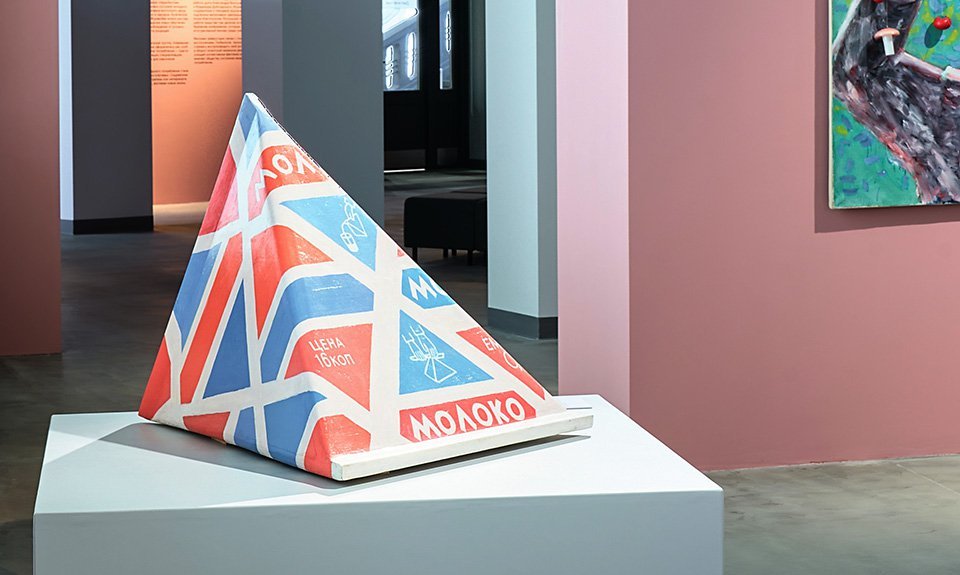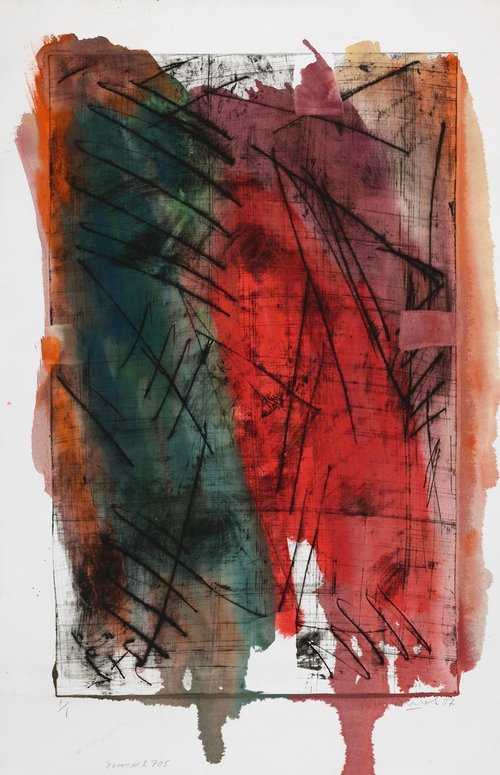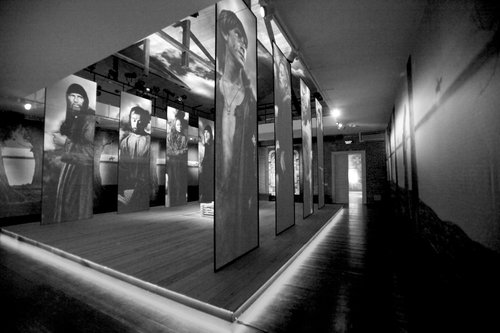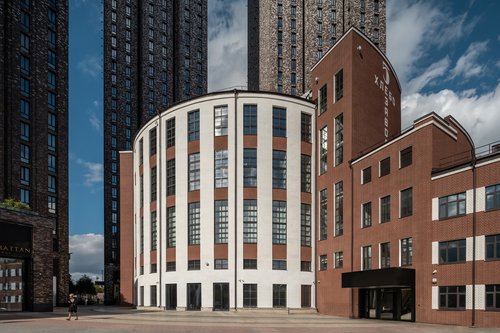State Tretyakov Gallery Opens a New Branch in Samara

The exhibition 'For Taste and Colour. Images of Food in Russian Art' in the Samara branch of the Tretyakov Gallery. Photo by Evgeny Sharov. Courtesy of Samara Branch of State Tretyakov Gallery
The Tretyakov Gallery has opened its first branch outside its Moscow flagship in Samara. In a newly renovated historical constructivist building once designed by Russia’s first female architect, its inaugural show ‘For Taste and Colour’, is a mouthwatering evocation of food in Russian art.
First proposed almost a decade ago, this ambitious architectural and restoration project began to take shape in 2019. Now, with all the construction and organizational nightmares finally behind it, the State Tretyakov Gallery has officially opened its first ever branch in the Food Factory, a historic building in the Russian city of Samara. There are two further branches in the planning in Kaliningrad and Vladivostok, however Samara claims the title of being the Tretyakov’s ‘firstborn’
"The steps we went through are now being adopted by branches in the other locations," Mikhail Savchenko, director of the Samara branch, says “For example, we made a temporary space in the centre of the city while the construction was ongoing and they are doing the same now in Vladivostok. We had to take into account that this is both a branch of the historic Tretyakov Gallery and yet the building was also a food factory, which is no less important. A wider thematic frame emerged which we want to work with".
The museum complex including the food factory stands on the site of the Maslennikov factory, originally built in 1930–1932 designed by Russia’s first female architect Ekaterina Maximova (1891–1932), a staunch advocate of constructivism. The complex resembled the outlines of a hammer and sickle. With the ideological symbolism, there was also its functionality, the architectural form worked well the concept of conveyor belt cooking and serving food. At the time the scale of production was exceptionally impressive – nine thousand meals a day. The building is in many ways no less impressive, today deemed to be a masterpiece of constructivism.
The food factory did not exist in its original form for very long. From the 1940s onwards, the building was subjected to successive renovations and remodelling resulting in the deterioration of the reinforced concrete structures. The factory went bankrupt and the catering complex was acquired by a private owner, before being abandoned a decade ago and alarmingly scheduled to be demolished. Thanks to local enthusiasts and the support of State Duma deputy Alexander Khinshtein, the demolition was halted and the state reacquired the building. Initially, the plans were for it to house a branch of the National Centre for Contemporary Art (NCCA), but when the NCCA was restructured some years ago, the Tretyakov Gallery stepped in.
What turned out to be an epic renovation began back in 2019. The museum space comprises 8,000 square metres, a quarter of which are the exhibition halls on the first floor, located in the sickle, the original site of the dining halls. Spaces for educational programmes, creative workshops, an artist residency and the museum shop are also part of the overall design, as well as administrative offices and service buildings.
"We will be launching the artist residencies this summer," director Savchenko explains. “Our plan is to invite an artist together with another specialist from outside the artistic sphere like a hydrologist or a chef. It will be interesting to find new languages and themes at the intersection of different practices. For us, this is an area of experimentation. We also want to build close relationships with the community as we are located in a densely populated area of the city. The Balance Garden nearby is a good example, a wasteland landscaped to create a special new space, where fragments from the ruins of the Maslennikov factory, which had already been demolished, were placed among the plants. In the summer we will launch a project called ‘Vegetable Garden for our Neighbours’, an extension of the food factory museum and a community centre at the same time. Entrance will be free".
The food factory museum is located on the ground floor of the historic main building. The space is not huge, yet curators Nikolai Kislukhin, Maria Armen and Elena Vyaltseva, along with exhibition designers Dmitry Sorokin and Maria Armen and architect Yulia Napolova, have all come together to ensure it will work to the greatest advantage. This mini-museum is dedicated not just to Samara’s history with most of the artefacts on display from local sources, but also on public catering associated with the Soviet period, with a focus on constructivist approaches and practices of that era.
While ‘For Taste and Colour. Images of Food in Russian Art’ the inaugural exhibition is predictably dedicated to food the flavour is a purely artistic one. The Tretyakov Gallery in Moscow has lent most of the artworks to the show with several also coming from private collections and from artist studios. Predominantly paintings from the 1820s to the present day, there are also objects, installations and video artworks, in total, 92 works, including some of the gems of the Tretyakov Gallery’s permanent exhibition, such as ‘The Aristocrat's Breakfast’ by Pavel Fedotov (1815-1852) and ‘Hunters in the Wilderness’ by Vasily Perov (1833-1882). Exhibition curator and director of exhibitions in the new Samara branch of the State Tretyakov Gallery, Konstantin Zatsepin, admitted the initial concept evolved over time.
"We set ourselves the aim of breathing new life into the building and establishing our identity, " he said. "It was an organic process, creating an exhibition about food and the experience around it. At first, in 2021 just coming out of the pandemic we were very conscious of the anthropological problem of loss of taste as a result of illness. Taste is one way of our contact with the world and with physical matter. However, this problem later became less important, and what emerged later was sampling the simple joys of life in spite of everything. We conceived it as a contemporary exhibition with a few traditional touches but now perhaps the opposite is true – it is more of a traditional show with contemporary elements."
Writing in the show’s catalogue, Zatsepin explains the structure of the exhibition which is based on “the image of a meal as a cyclical plot” in three parts, a chain that repeats the human rhythms associated with the satisfying of hunger and pleasure from food: anticipation, enjoyment, satiety". There is the painting ‘Zemstvo Dining’ by 19th century realist painter Grigory Myasoedov (1834-1911) juxtaposed with the photorealistic canvas ‘Food and Rest’ by Semyon Faibisovich (b. 1949), depicting the everyday life of homeless people, rather than chronological, linear approach it is about vivid and emotional experiences. At times there is too much complexity, and while the scope and scale of the food factory’s exhibition spaces are indeed impressive, the well thought-out curatorial concept can be somewhat blurred in the context of this space big on personality. Yet it never falls apart. A huge advantage of this exhibition is the presence of a large number of strong, heart-warming works from different periods.
What's next? one might well ask. "Two projects are currently under consideration," Mikhail Savchenko reveals. "Just now we have colleagues from other museums here with whom we are having discussions. There will be things not only from the Tretyakov Gallery. I can't disclose details yet."
This article was first published in Russian on the website of ‘The Art Newspaper Russia’ on May 31, 2024.
‘For Taste and Colour. Images of Food in Russian Art’
Samara Branch of State Tretyakov Gallery
Samara, Russia
June 2 – November 3, 2024

















